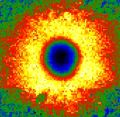Speaker
Description
Electron deficit diketopyrrolopyrrole (DPP) functionalised with an electron donating unit acts as a donor-acceptor molecule, offering conveniently tunable spectroscopic properties. DPPs have proven success in dye application and shown potential for use in photovoltaics. Understanding the photophysical properties is crucial for their application as organic materials, especially in the near IR region, where in-depth studies are limited. In this study, we employed femtosecond pump-probe spectroscopy to investigate the photophysics of thiophene linked DPPs. The thio-DPPs are further functionalised by different electrons withdrawing terminal groups, namely benzoxazole and thiophene dicyanide, which enables absorption in the near-infrared region. The benzoxazole derivative is strongly emissive and undergoes direct relaxation to the ground state in the chloroform solution. Thiophene dicyanide derivative exhibits a distinct spectral evolution within the first 10 ps, which is associated with structural and vibronic processes. Subsequently, it crosses over to the triplet state with a high yield of 20%. In the solid-state (thin film), a signal was observed that resembles singlet fission. However, upon careful anaysis of temperature-dependent steady state absorbance spectra, it was concluded that these features are the result of laser induced thermal artefacts. We described a simplified excited state evolution in the thin film that does not include any additional excited states. These findings have significant implications for the analysis of triplet formation, which plays a major role in the photophysics of many organic materials.

